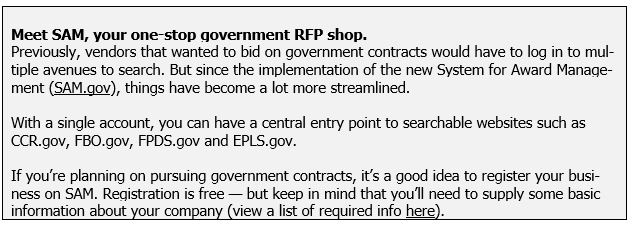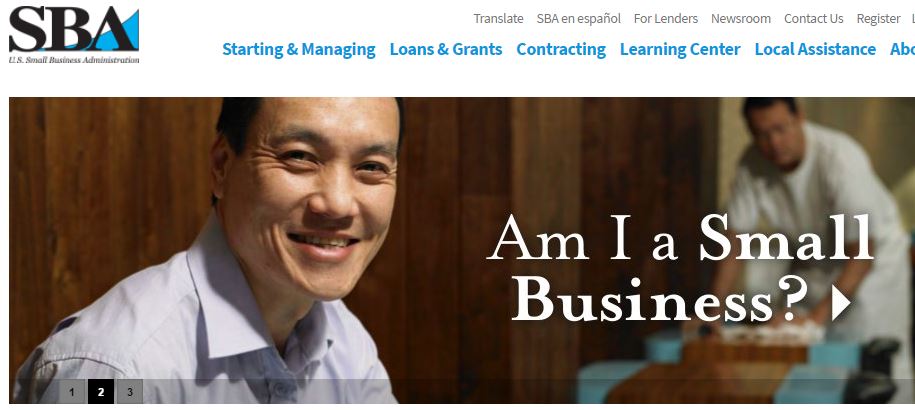Tag: IT/Software & Telecom
NAVIGATING A SUCCESSFUL PROPOSAL PROCESS: PART 2 OF 3
We’re Going Forward. What Next?
The Go/No-Go meeting was held, and the decision’s been made: Your company is going forward with the proposal.
Now the ball is back in your court. You’ve managed a proposal team before, but the contract was simple and called for far fewer resources. This one will require input from several divisions, and somehow, they all need to coordinate on a single 100-page document in just a few short weeks.
You know the first step is setting up your team, but you’re not sure who should be on it. What resources do you need, and what should they do?

Choosing the Right Team
We asked a series of experts on proposal writing for some tips and best practices on setting up proposal teams. Meet our experts:
- Stephanie Hashagen – Professional writer who frequently works on clients’ proposal teams
- Dan Hewitt – Process safety specialist who participates on well-orchestrated proposal teams using a proven approach at a major engineering firm
- Marion Winsett – Career sales manager in oilfield equipment who has negotiated contracts and written countless proposals
They gave us some time-tested advice, starting with a very important key concept:
Be realistic.
It’s easy to put together a team based on a best-case scenario. It’s much safer to put together a team based on a real-life scenario.
That is, assume the RFP will take more time than you think, and your team will have less time than they think.
“It’s imperative you choose individuals who are capable of responding quickly to the proposal time constraints,” Hashagen says. “Be sure they don’t have too much on their plate, and consider whether their other responsibilities might require them to address something unexpected that is time critical for another client.”
The size of your team will likely depend on the size of your company and the complexity of the proposal. However, for most proposals, eight key roles must be filled.
- Proposal manager
- Sales team representative
- Contract manager
- Subject matter experts
- Estimator
- Writer
- Graphic artist (optional)
- Editor
A few of your team members may wear more than one hat, but Hashagen advises, “Remember to be realistic and be sure there are enough people on the team to meet the deadline.”
Proposal Team Roles
A. Proposal Manager
Who is in charge of getting this proposal to the finish line?
Since you brought the proposal this far, you might be the assumed leader for this proposal project. But keep in mind that you may not be the best choice for the role of proposal manager.
To be fair to yourself and your team, you must consider your strengths and the demands on your time:
1) Are you extremely detail-oriented, comfortable with pestering people, and used to juggling tight schedules on a day-to-day basis?
2) Are you managing other proposal teams, or are there significant demands on your time outside the proposal process such as managing other projects or generating sales?
You must be able to answer yes to the first question and no to the second before you should consider yourself for the role of proposal manager. Failure to consider these questions honestly can result in a proposal that looks and reads like it was hastily put together.
Hashagen goes on to outline the proposal manager’s responsibilities:
- Managing the schedule to make sure all deadlines are met
- Tracking the progress of each part of the proposal package
- Maintaining close communication with everyone, including subcontractors, who will provide information for (or write sections of) the proposal
- Collecting the information and the draft documents and distributing them to the right parties, or, if documents are to be routed and tracked in a document management system, ensuring that the information is relayed by the deadline and tracked in the system
- Providing the reviewed and revised input to those who will produce the final version of the proposal
- Distributing the package to the final review team
- Ensuring that the final review comments are provided to the proposal writers, the final proposal package undergoes a rigorous proofreading process, and the proposal is delivered on time.
B. Sales Team Representative
Hewitt emphasizes the importance of having someone from your sales force on the team.
“A person involved in external sales can provide important information about the company issuing the RFP. A person in inside sales lends experience in the proposal process and the proper organization, formatting, and template (if any). Either one can review the finished package with an experienced eye.”
C. Contract Manager
Not to be confused with proposal manager, this person is the individual designated to manage the project once the contract has been won.
Depending on the demands of his or her current project, the contract manager may or may not be expected to participate on the proposal team.
“In instances when the contract manager is too heavily involved in another project to participate on the team, the proposal manager relays team members’ questions to the contract manager and provides information from the contract manager to the team,” Hashagen says.
D. Subject Matter Experts (SMEs)
Select an SME from each discipline who will be involved in project delivery if the contract is won.
“The SME may simply provide the necessary information for a particular section or sections of the proposal,” Hashagen explains. “Or the SME may actually write the initial drafts of the sections pertaining to his or her discipline.”
SMEs participate in proposal team meetings so that important questions aren’t overlooked. Interdisciplinary communication improves the consistency and accuracy of the initial drafts.
The combination of the SMEs’ expertise and experience is the reason your company should be chosen above your competitors.
E. Estimator or Proposal Finance Manager
This person is responsible for providing the projected costs that the RFP requires.
If the estimator or proposal financial manager does not participate on the team itself, the person in this role is still responsible for providing the numbers to the proposal writers and for proofing the final proposal to ensure the accuracy of the financial data.
F. Writer
Your proposal package must be cohesive and written in a single voice. Although there are multiple contributors, someone must write the proposal so that it is properly organized, precisely stated, and consistent.
In addition, the writer ensures that the proposal has an executive summary, a table of contents, and a conclusion, as well as a list of tables and figures and a list of related documents when required.
If your business employs a writer or communications specialist, that person may serve as the writer. If not, a writing agency can be contracted for this role. How the writer proceeds will be determined at your first meeting.
On some proposal teams, the proposal manager funnels all the information to the writer in the form of SME-drafted content and financial data.
G. Graphics Artist (optional)
If your template requires custom artwork for each proposal or you are preparing your first response to an RFP, you may need a graphic artist. This team member ensures that logos, illustrations, workflow diagrams, and organizational charts are attractive, consistent, and accurate.
In an article for Entrepreneur called The 10 Things You Need to Know When Responding to RFPs, George Debb, managing partner at Red Rocket Ventures, suggests, “Intersperse the company’s logo and images throughout the presentation so you look like you put customized work into your response, tailored just for your recipient.”
H. Editor
A capable editor carefully proofreads the final package with a fresh set of eyes. Significant errors in the proposal may cause the potential client to question whether your approach to the project itself will be less than fastidious. The editor must carefully double check the entire proposal to ensure that every deliverable requirement and every stipulation in the RFP has been addressed.

Addressing the Need for Outside Resources
It is likely that you addressed the need for additional resources in your early discussions with key personnel within your company, and also during the Go/No-Go meeting. (See our first blog post in this series, ““To Bid or Not To Bid.”)
If subcontractors are required, a team must be assembled to source and select the contractors. This team is often independent of the team writing the proposal and may be members of your sales force, as they likely have existing relationships with the subcontractors.
This selection team must begin its work as soon as the decision has been made to proceed with the proposal.
When selecting a subcontractor, your selection team should consider how much of the proposal you’ll need the subcontractor to handle.
Winsett stresses the importance of working closely with the subcontractor(s). “The (proposal) team and the subcontractor must agree to the terms in the RFP. Terms stipulated in the RFP that the subcontractor sees as roadblocks must be addressed immediately.”
Depending on the complexity of the contract, the subcontractor selection team or some of its members “may be required to work with the subcontractors throughout the proposal process,” Winsett adds.
Providing for Content from Sources Outside Your Company
If the only information from outside sources is the cost of materials or hourly rates for extra resources your employees will be managing, the proposal team’s estimator can furnish that data.
In cases where the subcontractor contributes expertise or unique solution, the subcontractor may need to provide proposal content. In that case, the proposal manager will transmit their contribution to the appropriate SME for review and to the writer for editing.
Next in this Series: Ensuring a Successful Kickoff
Now you’re equipped to map out the key roles your proposal team should include and identify the optimum people to fill them. You also have the information you’ll need to help your team members understand exactly what they’ll be expected to do. Now all you have to do is hold a kickoff meeting with your team to get the proposal process in gear. What should you cover? How can you avoid missteps — and the risk of confusion, communication failures and missed deadlines?
Read the third blog in our series to learn how to prepare for your kickoff and what you’ll need to cover to give your proposal the best possible chance of succeeding.
Are You Writing for You or Writing for Them?
A Tip on How to Balance Good Writing with Good Customer Service
I had spiders in my garage. Lots of them. Probably hundreds, to be honest.
But they were just in my garage — they hadn’t infiltrated my home. Yet. In fact, I hadn’t seen a single spider in the living room, the bedroom, or the bathrooms, and I kept trying to tell that to the lady on the other end of the phone. The problem was, she wasn’t listening.
Pest Control Lady continued to insist her company didn’t sell pest treatments just for the garage. I needed the whole house done. And not only that, I needed a quarterly pest treatment plan. Yeah, OK. So, I called the local guy, who did it my way. And, you know what? It’s half a year later. And still no spider re-infestation.
So, what does that have to do with writing? Well, listening to your clients — I mean truly listening — is hard. And just like Pest Control Lady, copywriters often try to force clients into their own mold.
But, ultimately, trying to convince a client to take on a copy style that they don’t like is not going to work. It certainly won’t work for the client-copywriter relationship, and in many cases, the end copy doesn’t convert well to sales, either.
Why? Your clients may know more about marketing than you give them credit for.
Clients who have been in business for a long time tend to know their customers — and they often attract customers who are very similar to them. So, if, for example, your client is fascinated by the workings of shot peening — their clients may actually be interested in that, too.
The trick is to balance what you know about best practices in writing with what your clients know about their business. Tweet this
Maybe you don’t put the mechanics of shot peening on the home page, or front-and-center in the brochure. But there probably is a good place for it, if your client thinks their clients want to know.
So, tip of the day: avoid copywriter hubris. Find out what marketing approaches have been successful for your client in the past, and leverage them.
Don’t reinvent the wheel, and don’t exterminate the copy angles that are already pest-free.
NAVIGATING A SUCCESSFUL PROPOSAL PROCESS: PART 1 OF 3
To Bid or Not to Bid
You’ve just received a Request for Proposal (RFP). You’re elated. It’s a sizable contract; capturing the contract and the customer’s repeat business would be an enormous leap forward for your company.
Then you begin to look at the RFP. It’s a 100-page document full of jargon, legalese, and pages upon pages of requirements you may never have fulfilled — at least on this scale — and the elation fades to doubt. When you see the proposal deadline, a mild panic sets in.
Where do I begin? Should we even try to tackle this? How should I put the best team together? How can we pull this off with the least stress and the most efficiency?
These are the questions we’ll address during this three-part blog series. Take a deep breath, and follow these first steps toward a thorough, well-managed proposal process.
First Things First
Remember, a Request for Proposal is just that: a request. You are not obligated to respond, and, depending on the requirements outlined in the RFP, you may not want to respond.
The first question to ask is whether this contract will truly benefit your company.
Daniel Hewitt, a Process Safety Specialist with a Houston-area engineering firm, emphasizes, “This is a question you should take very seriously. Not all contracts are worth pursuing. No matter how big the contract, no project is worth pursuing when it is doomed from the start or is likely to damage your reputation.”
Answering this question requires a thorough analysis of the RFP and some legwork on your part.
Analyzing the RFP
 Before making a decision about submitting a proposal, you must begin gathering information. Calmly read the RFP from cover to cover. Use a highlighter, write questions in the margins, take notes, and study it. Be thoroughly familiar with it before taking it to other people in your organization to avoid misinforming anyone involved.
Before making a decision about submitting a proposal, you must begin gathering information. Calmly read the RFP from cover to cover. Use a highlighter, write questions in the margins, take notes, and study it. Be thoroughly familiar with it before taking it to other people in your organization to avoid misinforming anyone involved.
Watch for buried requirements. Requirements may be lurking in a footnote, a table, or in very small print beneath a drawing; missing them can cost money or hold up the project.
Paul Munger, 30-year employee and project estimator for Dallas-based T W Design, illustrates this point. “For example, your company may ordinarily paint the machinery for its contracts. An asterisked note in 6-point type says something is to be powder coated. If you were to paint it and then be told by the client it was to have been powder coated, it could be very costly. And your company would have to absorb the costs.”
Look for information that is not there. “Often there is information missing from the RFP that may be critical to project delivery,” Hewitt said.
“Make a list of any questions you have concerning what seems to have been left out. Bring up any concerns you have about missing information with those who may be affected: the estimator, the procurement manager, the person who will head up the project if the contract is won, and the person in charge of company or contract finances.”
Note the deadline for asking questions. The company issuing the RFP will typically answer questions and clarify items in the RFP — up to the designated cutoff point.
Companies handle these requests for clarification differently. Some answer an individual company’s question(s) independently. Some route the response via email to everyone on the bid list. Others hold a meeting to which all bidders are invited, and questions are answered at the meeting.
“Just be sure to submit your questions prior to the deadline,” Munger said. “Only rarely will you be able to ask anything afterward.”
Scrutinize contract terms and up-front costs. For example, Marion Winsett, a career sales manager in oilfield equipment, said, “Does the contract require that you or any subcontractor post a performance bond?” Winsett recalls a contract his company bid on and lost. The RFP stipulated that a particular subcontractor be included on the project. It further required that the subcontractor post a $1 million performance bond. The subcontractor refused to agree to the performance bond, and the workaround Winsett’s company offered in its proposal was rejected.
“Our failure to come to an agreement on that single issue cost us a huge contract.”
Munger recommends paying attention to any other type of mandated insurance and specifications requiring a longer warranty period than is normally offered.
“Check with the procurement manager regarding the cost of additional warranty coverage,” he advised. “When you find a company willing to offer an extended warranty, it is likely to cost more or require extra lead time.”
Addressing contract terms up front is extremely important, Hewitt said.
“A lump sum or turnkey contract must be examined with a fine-toothed comb. If the RFP is not well thought out, and your questions related to missing information are not resolved early on, that is a huge red flag.”
Perhaps you shouldn’t respond, as committing to a poorly defined project could seriously affect project success.
Assess the resources required and the contract schedule. Make note of the number of resources and the sequence in which resources will be required. You may want to involve subcontractors rather than increase your workforce or try to expand your services.
How many employees and/or subcontractors will be needed at project startup? When will the resource curve be at its height, and how many resources will be needed? What about closeout?
“Ask the contract manager to estimate resource requirements and immediately apprise you of potential roadblocks,” Munger advised.
If subcontractors are required, a team must be assembled to source and select the subcontractors immediately after the determination to bid the contract has been made.
This team is often independent of the team writing the proposal team. The subcontractor selection team may be members of your sales force, as they likely have existing relationships with subcontractors.
Winsett stresses the importance of working closely with the subcontractor(s).
 “The selection team and the subcontractor must agree to the terms in the RFP. Terms stipulated in the RFP that the subcontractor sees as roadblocks must be addressed immediately.”
“The selection team and the subcontractor must agree to the terms in the RFP. Terms stipulated in the RFP that the subcontractor sees as roadblocks must be addressed immediately.”
Understand what it will take to do the job. If the RFP calls for designing, building, repairing, or otherwise providing something that is not an item you normally provide, make sure that your estimate accounts for those things.
“Consult a representative of the labor force to determine how the task might be accomplished,” Munger suggested.
Make a list of the materials required and the associated specifications. If your company has an estimator and a purchasing agent, now is the time to seek their input.
Give the RFP, the list of standard materials, and the projected labor requirements to the estimator. Ask the estimator to read the RFP and let you know if he or she thinks you’ve underestimated your ballpark resource hours or failed to note some critical materials or equipment.
If the RFP calls for any nonstandard items, take your list of nonstandard items to the purchasing agent. Ask the purchasing agent to read the RFP to double-check your list and to let you know immediately if there are issues related to product availability, backorders, and long lead times.
If your company doesn’t have a designated estimator or purchasing agent, enlist whatever help you can get so that issues regarding the cost of materials and any nonstandard items can be addressed immediately.
It’s Time to Decide
As soon as you have read the RFP and received some key players’ assistance, head straight to the person with the purse strings. Discuss the terms of the RFP regarding up-front costs, terms of payment, and additional staffing.
After your discussions with the financial officer, the estimator, and the project manager, Hewitt emphasizes that you should have a “Go/No-Go meeting.”
This meeting should include the persons just mentioned and any others you’ve involved who may have foreseen a red flag on the RFP, as well as the top decision-maker for your company or division. Brainstorm how issues in financing, staffing, and materials acquisition might be resolved.
“Set aside your belief in how important this client’s business might be,” Hewitt said. “Consider whether the roadblocks you’ve identified could actually result in project failure, a damaged reputation, or financial loss.”
You must resolve the issues or agree to pass on this one.
Next in this series: We’re Going Forward. What Next?
If you’ve struggled with previous proposals — possibly in the form of all-nighters, frustrated teams, and a mess of email miscommunication — then you know just how wrong proposal preparation can go.
Setting up the right team from the start can mean the difference between smooth writing and proposal hell. From sales reps to SMEs, learn who should be on your proposal team to keep the writing on track and help secure a winning bid.
Why Content Marketing Fails in Information Technology (and how to fix it)
As the world moves toward an increasingly digital existence, the IT industry has been growing more than ever. With that growth comes a need for IT companies to stand out from the pack and establish themselves as leaders in their field.
Content marketing — which is a form of self-promotion that uses web content such as blog posts, emails, white papers to help companies build relationships with potential customers — has long been celebrated as one of the best ways for a company to establish authority in their field.
Content marketing isn’t a one-size-fits all solution, though. Sometimes you may find that, despite your best efforts, you’re just not achieving your goals. People aren’t sharing your posts (or even reading them). No one has liked any of your Facebook posts, and your email open rate is just embarrassing.
It’s OK. This happens all the time. IT can be a tricky field from a content marketing perspective. Even though IT spending is on the rise, finding a way to engage with your customers (past, present, and future) can be tough.
If you’re an IT marketing manager who’s been trying to figure out why your content marketing efforts haven’t been doing what you’d hoped, you’re in luck. We’ve put together a helpful list of common mistakes that people make when putting a content marketing strategy in place for the IT world.
As an added bonus, we’ve included a few helpful tips to break the cycle.
It’s Boring!
IT is one of those fields where everything is technical. It doesn’t matter if you’re talking server capacity, redundancy, or uptime; you’re going to be describing something where details matter — but you have to choose the right details, or you will inspire a non-optimal reader behavior. This is, they’ll stop reading.
That’s because no one wants to read something that isn’t interesting. Not you, not your boss, and definitely not your potential customers. If you’re spending time creating content that isn’t exciting, your content marketing efforts aren’t going to achieve your goals.
Engaging content does several things:
- It tells a story. And when it’s appropriate, it tells your story.
- It helps people connect with your brand. The more people understand you, the more likely people are to spend their money with you.
- It’s sharable. The more interesting your content, the more people are going to want their friends, family, and — most importantly — their business contacts to see it.
The thing is, just because you’re in what many people would consider a boring market, doesn’t mean your content has to be boring.
A lot of industries fall victim to this trend, but you don’t have to.
Paddy Padmanabhan is the CEO of Damo Consulting, a B2B health care technology firm that specializes in thought leadership. “Most people don’t realize that being good at what you do, doesn’t mean you can write about it,” he says.
Take the time to learn about storytelling. Being able to tell the kind of story that people want to read can turn any topic into something interesting.
A great example of this is the TV show, How It’s Made. Working in a factory is about as boring as it gets. You do one task, like putting empty boxes on a conveyor belt. All. Day. Long. The job itself is pretty uninspiring.
What is interesting, though, is the process of manufacturing. How It’s Made nails this with well-produced, highly engaging segments on everything from light bulbs to fishing rods. It’s been so successful in telling the story of manufacturing that it’s been running since 2001. If a TV show can do that with something like manufacturing light bulbs, you can tell the fascinating behind-the-scenes story of your IT solutions.
Quantity Over Quality
Some people think that if they start a blog and load it with as much content as possible, they’re running a successful content marketing campaign.
They’re not.
What they are doing is filling up space — space that could be used to publish high-quality content that readers and potential customers will love — with fluff.
Fluff isn’t a good thing. No one likes fluff, not even people who produce cotton balls.
Liz Bedor is a content strategy manager who works in the health care technology sector. “It’s all test and learn,” she says about trying to figure out how often to post content. “Start with one a week and go from there.”
It helps to set goals with your content marketing efforts, Bedor says. They could be something like generating leads and building your email list.
Whatever your goals may be, your content needs to drive people towards those goals. If your one post a week isn’t quite doing what you’d hoped it would do, try two posts a week. Keeping tinkering with the frequency of your posts until you find the spot that is hitting all your goals. Stick with it.
Not only do people appreciate well-crafted content, the more time you spend publishing and producing that content, the more likely you are to become one of those places that people go to for information (like Slashdot or Ars Tehcnica).
Attaining this level of readership is a gold mine for any industry, but in the IT world, people love thought leaders. It’s not always easy to attain thought leadership status, but the value that comes from being a thought leader is undeniable.
You Don’t Promote it

This is a big one.
You could have the best, most engaging content in the world … but if you’re not sharing it, telling your friends to share it, or talking about it on your email list (we’ll talk about these next), no one is ever going to see it.
Love it or hate it, social media is undeniably a great tool for getting your content out there, especially in the IT world. If you don’t have a social media presence, now is the time to get one. Social media might not lead to more sales, per se, but it’s a great way to let people know you’re there and showcase your content.
Interestingly enough, for IT professionals, LinkedIn is the place to be. Up to 80 percent of IT professionals consume content on LinkedIn at least once a week. So if you’re not on LinkedIn, get your company a profile and start posting your content up there ASAP.
“Tech professionals are all about LinkedIn,” says Padmanabhan. “They are looking at LinkedIn all the time, checking it out at least once a day. It’s where they gather to exchange ideas and share articles.”
Not only is the platform a good one for helping educate yourself, he adds, but it’s a great medium for promoting your content. LinkedIn helps you target very specific audiences, and regularly posting there increases your chances of other tech professionals reading your content.
We’ve already talked about how IT professionals love to follow influencers and thought leaders, but they’re also big on social media sharing. If you haven’t managed to establish yourself as a thought leader, see what you can to do to get one to share your content.
The more shares you get, the more people see your content. The more people see your content, the more people think of you. The more people think of you, the more likely they are to visit your site when they have an IT need.
You’re Using the Wrong Kind of Content
Every bit as much as you need your content to be interesting, you need to make sure you’re using the right kind of content.
This is an easy one to overlook because every industry is different. If you’re not paying attention to current trends, you’re going to end up publishing the wrong kind of content for your audience.
First of all, despite what you’ve heard, email isn’t dead. Not by a long shot. If you’re not using email, you’re missing out on one of the best ways to engage with your customer base.
Well-written emails can point people in the direction you want them to go and help them make critical decisions for their company (like choosing your solution over a competitor).
Secondly, IT professionals love content that is:
- Relevant to their company
- Helpful with skill development
- Interesting to others in their network
- Engaging (this is one of those things that comes up time and time again)
If you want to reach IT professionals, your content needs to be some combination of these things (like an engaging series of blog posts that other IT professionals could use to stay current, for example).
Finally, it helps to understand what kind of content IT professionals consume. If there’s one thing IT pros love, it’s white papers. They consume almost 30 percent more white papers than non-IT professionals. When you think about it, it’s kind of a no-brainer. Padmanabahn says that C-level executives, like CEOs and CIOs, love white papers because they allow them to quickly cruise through the content and gather up the relevant pieces of information about the topic, product, or trend they’re reading about.
IT professionals also have a pretty healthy appetite for webcasts and podcasts, so don’t overlook these content platforms when you’re planning out your strategy.
Ultimately, the kind of content you use depends on who you’re targeting.
You’re Winging It
Very, very few things work out the way you’d want them to if you don’t have at least some kind of plan. Content marketing is no different.
Not having a documented strategy in place could be the thing that kills you, even if your content is killer.
It’s easy to just sit down and start producing content. There’s always something to write about, no matter what your industry is. The problem is, if you’re just posting random blogs or sending out emails that don’t have a purpose, your efforts will inevitably fall short.
Taking the time to thoughtfully plan out your content makes all the difference in the world. The key thing is to write down what you hope to achieve with your content marketing efforts. If your goal is to attract potential new customers to your site, producing high-level content aimed at people who are already customers isn’t going to help.
Here’s a great example of a company that did things right. Logicalis, an IT company based out of the UK, came up with a plan that revolved around putting out an ebook that their prospects would find interesting.
Instead of just throwing together an ebook and posting it on their website, they put together a plan that combined the use of a microsite (a series of eight web pages that existed separately from their main web page), the ebook, and a series of emails.
The end result was $8 million in new sales for their HP products.
Of course it wasn’t just a matter of putting together an some emails and a microsite, either. Each phase of the plan was carefully thought out using a brand storytelling agency.
First of all, they had a goal, which was to increase sales of a certain product using a non-sales approach. The ebook topic was determined by sitting down with the sales team and figuring out what pain points potential customers were experiencing — they did this by following conversations people were having.
The end result of talking to their potential customers was an ebook called Elements of Design: How the Data Center of Today Can Be The Data Center for Tomorrow.
Once they had a topic, the next step was figuring out how to reach potential customers. A series of six emails was put together to help drive traffic to the microsite. Each of the emails addressed a particular need that potential customers may have had and directed them to a microsite where they could download the ebook.
The emails were sent out to a segmented list of 2,000 prospects based on what they had either previously purchased or expressed an interest in.
The microsite was designed to capture leads by offering a just enough of a taste of what the ebook contained that they would want to enter their information and download the ebook. From there, Logicalis followed up with leads via the phone and, eventually, moved further them down the sales cycle.
Compare that approach to going to the grocery store without a shopping list. Sure, you can do a successful grocery shop without a grocery list, but odds are, you’re going to discover that you left out a main ingredient for dinner because you were distracted by the cookie aisle. It happens to the best of us.
Having the proper plan in place will keep you focused. You might still get distracted by cookies, but you’ll have a constant reminder of why you went to the store in the first place.
You Don’t Understand what Your Customers’ Needs
Sometimes, no matter how successful your company is, you can be disconnected from your customers. This is something that can easily happen if you’re been in the business for a while, especially if things are going well. It’s easy to think that, because your business is successful, you’ve got your customers figured out.
And you know what? You probably do. At least to a certain degree. The thing is, though, while you might be dominating in one area of your customer’s desire, you could be underservicing another.
The easiest way to solve this problem is to simply talk to your customers. A quick survey could show you that, while your customers are happy with what you do, a lot of them might wish you offered a related service. In fact, you might discover that you do offer that service, but they don’t know about it.
Interviewing past customers is another great way to find out if you’re meeting all the needs of your client base. “If you are struggling to understand the topics you should be using,” says Bedor, “then talking to the customer helps.”
Reaching out to customer success teams — whose job is to help develop customer relationships that promote retention and loyalty — can be another great way to figure out the kind of content that your customers want, according to Bedor.
Finding out what questions these teams deal with most often can be a useful first step to determining the kinds of content customers want.
Once you figure out those needs, you can start talking directly to those points in your content marketing. After all, there’s no sense in talking someone’s ear off about email servers when all they want to do is set up virtual workstations for their remote employees.
Creating content based on customer questions helps take some of the burden off the customer success team, too. No one wants to answer the same question 10 times day.
Moving Towards Better Content
Hopefully, by now, you have a sense of what might be going wrong with your content marketing efforts. It usually doesn’t take much to set things down the right path (reading this is a great step toward correcting the problem).
As with a lot of things, there’s bound to be a little bit of trial and error involved with figuring out your ideal content marketing strategy. But with everything from light bulbs to dishwashers being connected to the internet, there’s never been a better time to be in the IT field.
The ABCs of RFPs
New to proposal writing? It helps to learn the language.
If you’re new to the world of proposals, it’s all too easy to get lost in a sea of acronyms, industry jargon, formatting rules, and submission guidelines. What’s the difference between an RFI and an RFP? How do you respond to an RFQ? What is a SOW? Is your company a WOSM or an SDVO? When do you send an LOI? And WTH (what the heck) is SAM?
This quick guide will help you decipher and make sense of some of the most common RFP lingo.
 Before we dive into what makes them different, let’s talk about what RFPs, RFIs, and RFQs have in common: They all help companies, government entities, and organizations find vendors that will provide the best services or products, for the right price. (Of course, there’s a little more to it than that. But for the purposes of this blog, we’re going to keep things basic.)
Before we dive into what makes them different, let’s talk about what RFPs, RFIs, and RFQs have in common: They all help companies, government entities, and organizations find vendors that will provide the best services or products, for the right price. (Of course, there’s a little more to it than that. But for the purposes of this blog, we’re going to keep things basic.)
The major difference here is the length, the type of information, and level of detail you’ll need to provide in your response.
An RFQ — or request for quotation is all about the bottom line. When an organization sends out an RFQ, they know they want certain products or services delivered over a certain time period — and they’re looking for a vendor who can provide those products
or services for the best price.
Note: an RFQ is essentially the same as an IFB, or “invitation for bid” — don’t let the names throw you off. They’re asking for the same thing.
An RFI — or request for information — is like a mini-RFP. Organizations often put out RFIs as a way to gather big-picture information and answer questions that will help them refine their search, more clearly define their needs, and vet potential vendors. The RFI process is a little like speed-dating in that it offers a quick, no-commitment way for organizations and potential vendors to get a feel for each other, decide if they want the same things, and figure out if there’s potential to take things to the next level.
At this stage in the game, it’s all about the big picture. If your organization receives an RFI, you’ll probably be expected to provide the following information:
- A company overview that includes things like how long you’ve been in business, any certifications, licenses, or awards you’ve received, and your areas of expertise
- A company org chart, plus bios and/or resumes for your key personnel
- A general budget/cost estimate
- References and/or case studies from similar jobs and clients
An RFI response is typically much shorter than an RFP response — and in some cases, there may even be a maximum page count. Responses should be clear, concise, well-written, and not too wordy.
An RFP — or “request for proposal” is the largest, most detailed, and most comprehensive of the three. A typical RFP combines elements of an RFQ and an RFI, plus specific information about the scope of work (SOW) and the vendor’s ability to perform the work or provide the services outlined in the SOW. When you respond to an RFP, you should be ready to answer detailed questions about everything from your company’s hiring and staffing processes to technology and security measures to your financial standing.
In addition to answering questions, you’ll likely need to provide documentation such as:
- A letter of credit from your bank
- Proof of insurance coverage
- Employee training materials and documentation
- An implementation plan and a transition plan
- Case studies and/or letters of reference from previous or current clients
Depending on the organization issuing the RFP, your response could vary in length from 50 pages to well over 100. In addition to ensuring that you’ve answered every question and responded to every item on the RFP, you’ll also need to make sure that you follow formatting instructions to the letter and leave yourself time for proofreading and fact-checking before the deadline.
Note: In many cases, the issuer of the RFP will require that vendors send a letter of interest (LOI) before responding to an RFP. An LOI is a simple, to-the-point letter that formally announces your intention to prepare and submit a proposal.
Public and private companies and nonprofit organizations typically send RFPs and RFIs directly to a pre-selected list of vendors. Government agencies, however, are required to publicly issue RFPs to ensure a fair and transparent bidding process (this is especially good news for smaller or younger companies who may not have the name recognition necessary for private invites).
If you’re looking for opportunities, check out your local city or state government websites. You can also use searchable databases that compile and maintain lists of open government RFPs.
Not sure where to look? Here are a few starting points:
- The Request for Proposal Database. This free, searchable site lets you browse hundreds of government and nonprofit RFPs in the U.S., Canada, and Europe. You can search by the type of service needed, and by location, and you can even pick up a few tips for crafting a winning proposal.
- Federal Business Opportunities. Search federal contract opportunities worth $25,000 or more. If you’re new to the site (or to the RFP process in general), be sure to check out their handy user guides.
- GovernmentBids.com. Search more than 35,000 RFPs and opportunities sorted by category and state. The best part of this site? You can also sign up for free email alerts customized to your industry and location, which means you’ll never miss an opportunity.
- GSA Acquisition Gateway. Although this site is primarily aimed at helping government agencies find qualified vendors and services providers, it does have some pretty great resources for vendors. And be sure to check out their related site, the GSA Vendor Support Center for even more tools and information.


Small business set-asides
If you’re a small business owner, you’re likely aware of the government’s small business set-asides, which helps ensure that small or under-utilized businesses have the opportunity to bid for — and win — government contracts. Some set-asides are open to all small businesses, and others are reserved for businesses that fit certain criteria or hold specific certifications, such as:
- 8(a) Business Development: This program is for companies that are at least 51 percent owned and operated by socially and economically disadvantaged people.
- HUBZone Program: This program encourages economic development in historically underutilized business zones.
- Women Owned Small Business (WOSB) Program: This program is for small businesses owned by women.
- Service Disabled Veteran Owned (SDVO) Program: This program is for businesses owned by disabled veterans.

If your organization fits into any of these categories, you may gain a small advantage. It’s definitely worth a look.
A final note on this: If you want to see a (darkly) funny take on small business set-asides, check out the 2016 film, “War Dogs.” Based on a true story, the movie follows a pair of gun dealers who pursue government weapons contracts through small government set asides.
Ready to get started?
We could, quite literally, write a book about RFPs. Several books, probably.
The learning curve required to write a winning proposal — combined with the often-intimidating list of required materials and documentation — can be a bit intimidating even if you’ve been through the RFI or RFP process a few times.
That said, the process of crafting a solid, well-written proposal does get easier — especially if you know the lingo.
Your company’s software and IT offerings are amazing but complex. The tech makes perfect sense to your R&D group… but those engineers have a hard time explaining it clearly to your clients or potential customers. After all the hard work of developing your software, don’t squander its potential.
You need to convert the highly technical IT-speak into language that clearly, logically explains the benefits of your company’s offerings to possible customers.
And to do that, you need writers who can break it down into terms your target audience can understand.

Experienced Technical Writers
The team at The Writers For Hire is full of technical writers who excel at deciphering highly complex IT concepts and boiling it down into digestible information.
We bring decades of experience working with clients in several highly technical industries. Specific credentials of some of our copywriters include:
- Over a decade of experience in web hosting and development.
- Techinical writer for the Department of Defense.
- Master’s in technical communication.
- Computer science degree.

Example Projects
RFP Responses
Most of our RFP clients come to us with hundreds of pages of information and a deadline that’s just a few days away. We can provide the technical knowhow and resources you need to get it done right – and on time.
User Manuals
By hiring a team that isn’t intimately familiar with product or service works, you can get an outside perspective – and ensure that your manuals and guides are comprehensive, helpful, and clear to new users.
Whitepapers
Our writers are naturally curious and genuinely interested in what your SMEs have to say. And we love whitepapers: reading them, studying them, and learning about leading-edge trends to apply to your project.
Content Marketing
Position your firm’s SMEs as industry experts with a series of thought leadership pieces.
Request A Quote
or
Call 713-465-6860
Gordon Graham “That Whitepaper Guy”
The whitepaper is arguably the keystone of a great content marketing campaign.
 A single, comprehensive whitepaper on an enduring industry topic can last years – creeping up month after month in search results, circulated and posted by peers and potential clients, attracting hundreds or thousands of mentions on social sites.
A single, comprehensive whitepaper on an enduring industry topic can last years – creeping up month after month in search results, circulated and posted by peers and potential clients, attracting hundreds or thousands of mentions on social sites.
The whitepaper can also be incredibly versatile. Think of a whitepaper as the Mr. Potato Head of the content marketing campaign. Pull out the pieces and put ‘em back together again for endless combinations – from email blasts to social media, infographics to speeches. (Need some ideas on how to make your whitepaper’s shelf life even longer? Check out our blog on repurposing content.)
Such a versatile and powerful document has certainly attracted the attention of a marketers in almost every major company in every major industry. (We listed just a few examples, below.)
But where do these things come from? Often, whitepapers are credited to a company’s subject matter experts (SMEs) – but are they really the ones writing these things? In the vast majority of cases, the answer is a resounding no. SMEs are busy people, and whitepapers – good ones, anyway – take hours of work. This is why almost all whitepapers are either ghostwritten, or at the very least heavily edited by professional whitepaper writers.
Like the whitepaper writing team at the The Writers For Hire, Inc.
Of course, we aren’t the only ones. There are a growing number of specialists in the industry. Like Richard Goulde, Wilton Blake, and options on sites like UpWork or Outsource.com.
 Gordon GrahamYet, arguably one of the most well-known players in the field is Gordon Graham, renowned author of the 2013 book Whitepapers for Dummies, who has been writing whitepapers since 1997.
Gordon GrahamYet, arguably one of the most well-known players in the field is Gordon Graham, renowned author of the 2013 book Whitepapers for Dummies, who has been writing whitepapers since 1997.
Gordon Graham was generous enough to interview with us late last year, providing us with some insider tips on whitepaper promotion, ROI metrics, and trends.
The Writers For Hire: What is a whitepaper, anyway?
Gordon Graham: It is a time-tested format for long–form copy that combines expository and persuasive writing, whose roots go back more than 100 years, and whose future stretches ahead for as long as companies sell anything relatively new, complex, and expensive that needs explaining to a B2B prospect.
The Writers For Hire: What is the best way to promote a whitepaper?
Gordon Graham: It should be promoted long enough and well enough to be effective. Promote it everywhere; promote it like a madman. Promotion plans consist of multiple tactics to give exposure to the whitepaper. So treat it like you would a product launch, use everything from social media to advertising.
The Writers For Hire: Have you seen any changes in the past couple of years in marketing strategies and tactics?
Gordon Graham: I think social media continues to grow. We have used LinkedIn and Twitter for a while now to inform each other about new documents. Now, people are posting covers of their visual media like whitepapers in places like Instagram and Pinterest. I guess I would say, look at every social media channel, especially if any of your prospects are using those channels. Any marketer should learn where their audience visits, in social media, and use those channels to present the whitepapers.
Also, companies are beginning to want to know specifically how much revenue is being generated by each whitepaper. They want to know how many downloads, leads, sales and revenues result from the document. They want to be able to say, ‘We can attribute $3.2 M in revenues directly to our XYZ-Whitepaper Campaign.
The Writers For Hire: What is the best way to quantitatively calculate whitepaper success?
Gordon Graham: Clicks, CTR, comments, cost-per-lead, downloads, email bounce rates, leads, likes, e-mail opens, open rates, page views, perma-links, registrations, reposts, revenues and sales can all be measured to determine the effectiveness of a whitepaper.
The Writers For Hire: How many whitepapers per year do your large company clients post and market?
Gordon Graham: For a large company like 3M, they are probably a Fortune 100 company, they may have seven major divisions. For example, a division might be ‘Healthcare.’ So each division would want their own whitepaper. In one year, a single writer may compose 10 whitepapers just for that one division. So that gives you an idea. On the other hand, a lot of mid-size companies who do just one whitepaper per year. So, it depends on the size of the company and their specific needs.
The Writers For Hire: How long does a whitepaper generate ongoing income?
Gordon Graham: As long as people are having the same problem that is being described in a whitepaper, the document could be generating interest for 10 years or more. For example, in industry, corrosion is a major problem that needs treatment. Unless new treatment to control the problem is invented, the original whitepaper, describing the effective solution, would suffice. There’s no limit to that. A “backgrounder” whitepaper will continue to work until the product changes. That’s why I like whitepapers…because they’re very meaty and substantial. Companies can put them on their website and they’ll work very hard. They work harder than any other kind of content and they last longer, literally years for some.
Many thanks to Gordon Graham for sharing his expert insights and knowledge for this blog! He’s a good guy and an amazing writer, so if you hire him, we’re OK with that. Although, admittedly, we’d rather you hire us.







